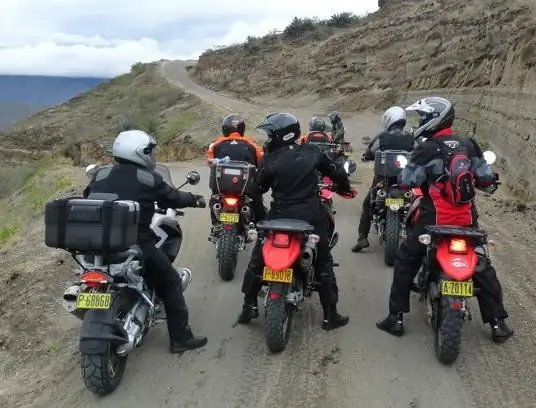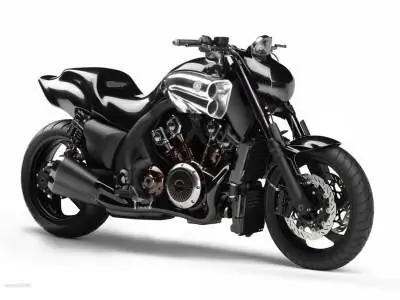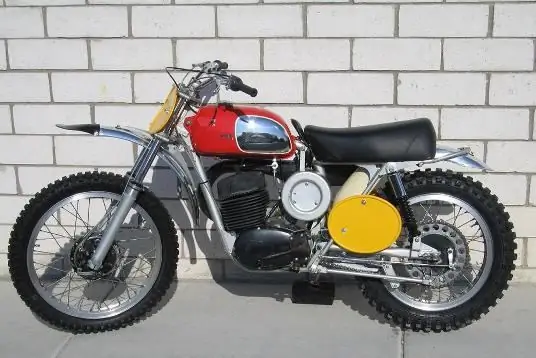2025 Author: Erin Ralphs | [email protected]. Last modified: 2025-06-01 05:35:55
It is believed that the first military motorcycles were created in 1898 by Frederick Sims. The car was equipped with four wheels, a bicycle-type frame, a saddle, a power unit with a capacity of 1.5 horsepower. Motor Scout, and this is the name the technique received, was equipped with a Maxim machine gun, an armored shield to protect the upper body of the driver-gunner, as weapons. The device was able to transport almost 0.5 tons of equipment, ammunition and other cargo. One refueling was enough for about 120 miles of travel. This version has not received serious distribution in the army.

Development of military motor-building
Already by the beginning of the First World War, military motorcycles were firmly established in the army units, were operated by all progressive states. The cars were designed to replace horses, so the soldiers-couriers were the first to use the vehicles in question.
The first operational copies appeared in the army units of Germany. Unlike the "progenitor", they were modernized civilian counterparts, reinforced with machine guns. Such mobile points, despite thin armor, successfullywere used in various operations on the fronts of the First World War.
Post-war revitalization
In 1928, the French military motorcycle Mercier was presented. The front caterpillar wheel added originality to this creation. After 10 years, engineer Leetr created a modernized analogue of the specified machine, called the Tractorcycle, fully equipped with a caterpillar drive.
It was assumed that excellent cross-country ability and light armor should have provided the model with recognition and success in the military sphere. However, the bike had a number of significant drawbacks:
- Large weight (over 400 kg).
- Low speed setting (up to 30 km/h).
- Bad handling.
- Road instability.
Despite the fact that soon the designers supplemented the design with side wheels, the army was not interested in this development.
Other original designs
The original model of a military motorcycle was developed in Italy. The Guzzi company introduced a tricycle with a machine gun and an armored shield. A feature of this modification was the "dead" placement of the machine gun, directed backwards.
Belgian designers also tried to create something unique in this regard. In 1935, FN presented a simplified model of the M-86. Compared to other European counterparts of that time, the car received a number of advantages:
- Forced 600cc engine.
- Reinforced frame.
- Armored front and side plates.
- Transportabilityarmored carriage with a Browning machine gun.
During the serial production, over 100 such copies were produced, operated by the armies of Romania, Brazil, China and Venezuela.
German military motorcycles
The leader of the German automotive industry, BMW, at first did not introduce any special innovations, mounting the M2-15V boxer engine on existing vehicles. The first completely new serial modification from German engineers was introduced in 1924.
Already in the early 30s, the Bavarian concern started updating the specialized military motorcycle BMW-R35. The model received a telescopic front fork, a reinforced power unit for 400 "cubes", a driveline, which is distinguished by a higher reliability indicator from the chain version. Among the shortcomings, “old” sins are noted, expressed in a rigid rear suspension and fragility of the frame under loads. However, the car was used in motorized units, police, medical battalions. The release of the device continued until 1940.

Simultaneously with the R35 version, BMW produced the R12 modification. In fact, this car was an improved version of the R32 series. The equipment was equipped with a 745-horsepower engine, a telescopic fork with hydraulic shock absorbers. In the design of the considered variation, one carburetor was removed, which reduced the power of the R-12 to 18 "horses". This modification gained its popularity due to its good parameters and low price, becoming the most massive representative of its class in the German army. Since 1924by 1935, more than 36 thousand copies were produced both in a single version and with a sidecar.
Of all the manufacturers of German military motorcycles, Zundapp, which focused on government orders, became BMW's main competitor. Production models: K500, K600 and K800. The last version with a cradle was especially popular, equipped with four cylinders. Such a feature, along with all the pluses, had its drawback in the form of frequent oiling of candles, since not all nodes warmed up evenly.
Military motorcycles of the USSR
After the end of the First World War in Russia, there was practically no own motorcycle production in the military direction. This situation lasted until the 1930s. The technical equipment of the army required modernization, in connection with which the development of the first domestic motorcycle began, capable of with dignity enduring all the hardships of the Russian climate.
The first army variants were modifications of KhMZ-350 and L-300. The first device became an almost exact copy of the Harley Davidson, significantly inferior to the American counterpart in quality. Subsequently, it was decided to abandon it. It was replaced by the TIZ-AM600 version, produced since 1931. Own development included British and American features, but did not show any special achievements.
In 1938, the Soviet design bureau presented several military models: L-8, as well as two IZHs, under indices 8 and 9. As for the first copy, it was produced at various factories in the country, which made their own improvements,which led to the loss of unification of spare parts.
CZ 500 Tourist
This Czechoslovak-made bike first rolled off the assembly line in 1938. Serial production did not stop until 1941. The motorcycle was intended not only for military needs, but was also operated by the civilian population. Only six hundred samples of the machine were born. A modernized version of this "iron horse" was released specifically for the guards of the Pope. The equipment was painted black, which goes well with the chrome parts of the device.
Harley-Davidson WLA
This military motorcycle has become one of the most common modifications around the world. It was equipped with a holster on a fork, painted in olive color. In total, more than 100 thousand copies were produced. It was this version that became the most popular after the war as conversions to choppers and casta bikes. In the USSR, the model came under Lend-Lease.

Welbike
The British Welbike is more like a mini bike with a motor. He had a folding design that allows him to be transported during the transfer of military units by air. In the future, he was going to and served to speed up the delivery of personnel to their destination, but did not receive much practical use.
World War II period
The first and only of its kind were two German military motorcycles with a sidecar: the BMW R75 and the Zundapp KS750. They are specially designed for off-road driving. Equipped specifically for this purposewheel drives and special speed, allowed to recommend these machines only on the positive side.
Due to the high price, the models in question were first supplied to the paratrooper units and the African Corps, and later to the SS troops. In 1942, a decision was made to produce an improved Zundapp KS-750 with a sidecar BMW 286/1 (military motorcycle with storage in a strategic reserve). It never went into production. Production was scheduled after the completion of an order for 40,000 R-75s and KS-750s, of which only 17,000 were produced.
Kettenkrad
From 1940 to 1945 this half-track modification was used to transport light-type guns, acting as a tractor. The equipment was set in motion by the Opel engine, with a volume of 1.5 liters. A total of just over 8,7 thousand copies were made, oriented mainly to the Eastern Front.
Caterpillars coped well with domestic off-road. Among the minuses is a high percentage of rollovers in sharp turns, while the landing system made it difficult for the driver to leave it quickly. In addition, it was impossible to use this transport to move on elevated places in a diagonal direction.
M-72
Military motorcycles of Russia of that period began to be created on the basis of BMW. Heavy equipment with a sidecar has been used in the USSR since 1945. The release of the car was carried out in five cities of the country. Until 1960. It was this modification that became the prototype for the future analogue under the Ural brand.

Initiallythe devices in question were focused strictly on the needs of the army. The base was equipped with a mount for mounting powerful small arms. The bike has rightfully become the most popular combat "iron horse". His image is even on one of the postage stamps. In total, more than 8.5 thousand copies of this technique were produced. Only in the mid-50s, the military motorcycle "Ural" from conservation went on free sale for the population.
Vespa150 TAP
These combat scooters were created in France for their army. The mass production of this type of equipment began in 1956, equipped with a powerful 75 mm cannon. Such weapons did not contribute to the widespread use of the bike in the ranks of the armed forces. At the same time, a motor with a modest working volume of 145 "cubes" could not provide a proper indicator of speed and mobility. The scooter developed a modest speed of up to 65 km / h. It is worth noting that the developers planned to use in pairs another similar analogue for transporting shells.

K-750
The Dnepr military motorcycle of this series has become an improved version of the M-72 and has been produced in Kyiv since 1958. The car was equipped with an "engine" with a volume of 750 "cubes", like other analogues of this series from other manufacturers.
Features and Specifications:
- Motor power - 26 liters. s.
- Improved comfort and reliability.
- Chassis made with shock absorbers with hydraulics.
- The carriage was equipped with rubber springs and a special suspension.
- The increased cross-country ability of the K-750 military motorcycle was provided by an improved drive mechanism for the cradle wheel.
- With the increase in engine power, fuel consumption has decreased by almost one liter.
New from the end of the last century
To strengthen the motorized rifle capabilities of the army, in the mid-90s, a military motorcycle "Ural" of the IMZ-8.107 series was developed with a side wheel drive of the sidecar, providing increased cross-country ability. The main purpose of the machine is to operate as part of patrol, mobile reconnaissance groups, for transporting communications systems and as a multi-purpose vehicle.
Smaller dimensions and increased maneuverability, compared to any army vehicle, make it the best tool for combat operations in the city. The crew consists of two or three people, the weight of additional equipment is from 25 to 100 kg.
A heavy machine gun of 12.7 mm caliber is used as the main weapon. It makes it possible to hit low-flying air targets and ground targets with light armor. In addition, weapons allow you to fight with enemy manpower at a distance of up to two thousand meters. Visibility determines the possibility of firing from personal weapons of the crew under the cover of individual armor protection.

Features of "Ural"
The high dynamics of the military motorcycle, the photo of which is shown above, the cross-country ability and maneuverability are provided by a powerful "engine", transmission and chassis. The bike haswheelbase shortened to 1.5 meters, large 19-inch wheels with an all-terrain tread pattern.
The design and layout of work items is made according to the automotive principle:
- Motor lubrication system.
- Checkpoint in a separate block.
- Drive shaft.
These features guarantee a high level of reliability and maintainability. The working life is increased by the use of suitable automotive-type engine and transmission oils.
Combat motorcycle "Ural" with a trailer has a parameter that is especially important for the performance of combat missions - the ability to overcome obstacles that are beyond the control of most vehicles. With the wheelchair raised, the equipment can move along one track while maintaining balance. This allows you to bypass deep holes and obstacles up to 70 centimeters high. The weight of the motorcycle is 315 kilograms, which makes it possible to turn the unit over by the crew through a fallen tree or barrier structure. Speeds up to 100 km / h provide a high margin of time for maneuvering, while the operation of the bike in question is possible in various climatic zones (from -40 to + 50 degrees).
Characteristics of IMZ-8.107
The following are the main performance characteristics of the Ural military motorcycle:
- Engine type - atmospheric four-stroke gasoline engine.
- Power rating - 23.5 kW.
- Formula wheel - 32.
- Gearbox - 4 modes with reverse.
- Frame - welded tubular type.
- Front/Rearsuspension - levers / pendulums with spring hydraulic shock absorbers.
- Voltage in the on-board network - 2 V.
- The maximum travel speed is 105 km/h.
- Cruising range on one gas station - 240 km.
- Length/width/height - 2, 56/1, 7/1, 1 m.
- Weight dry - 315 kg.
- Possibility of using weapons - machine gun 12, 7 or 7, 6 mm, ATGM, AGS, RPG.
- Additional equipment - fuel tank, searchlight, set of entrenching tools.
Harley-Davidson
Also popular in recent years is the Harley Davidson army motorcycle with a two-stroke single-cylinder Rotax engine with a volume of 350 "cubes". This modification is common in various countries of the world, it is operated as a vehicle for reconnaissance or escort. Among the shortcomings of this model is the use of J-8 fuel, which in composition is more like a mixture of diesel fuel and aviation kerosene. This makes it unsuitable for use on gasoline engines. There are exceptions, such as HDT M103M1. The average speed of the device is 55 miles per hour.

Kawasaki/Hayes M1030
Another diesel-kerosene modification of an army motorcycle. The car belongs to one of the most utilitarian variations. For the US Army, it was specially redesigned by Hayes Diversified Technologies. Prior to the 650 cc version, the predecessor was used under the KLR-250 index.
Recommended:
Touring motorcycles. Characteristics of motorcycles. The best touring bikes

Two-wheeled transport allows you to make long journeys. Modern touring motorcycles make it possible to do this easily and comfortably. Now a new type of tourism is emerging and developing - motorcycle travel
Military vehicles of Russia and the world. Russian military equipment

Military vehicles of the world every year are becoming more functional and dangerous. Those countries that, due to various circumstances, cannot develop or produce equipment for the army, use the developments of other states on a commercial basis. And Russian military equipment is in good demand for some items, even its outdated models
Motorcycle: types. Classic and sports motorcycles. Motorcycles of the world

Sport bikes differ from their classic counterparts in lightness and high speed. As a rule, all sportbikes are racing. By classic, they mean a regular motorcycle that serves for short and long trips
Motorcycles 250cc. Motocross motorcycles: prices. Japanese motorcycles 250cc

250cc motorcycles are the most popular models in the road class. Various modifications of the brands "IZH", "Kovrovets", "Minsk" can still be found today both on the highway and on city streets
Soviet motorcycles. Motorcycles of the USSR (photo)

The history of the domestic motorcycle industry is an integral and bright part of the global production of bikes. Izhevsk, Kyiv, Minsk and Kovrov factories can boast both famous victories and bitter defeats. Ultimately, the entire production of Soviet "iron horses" ended in complete oblivion

